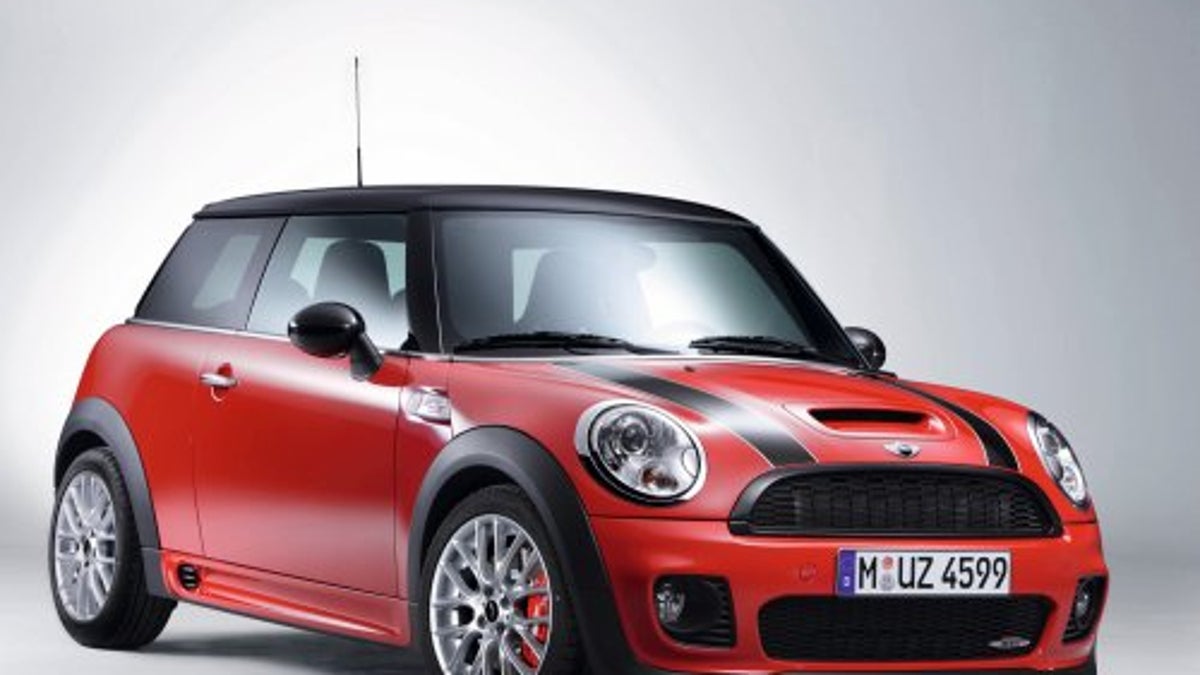Quick Look: '09 Mini Cooper John Cooper Works
A short look at MINI's high-performance John Cooper Works model.

Since its introduction for model year 2003, the Mini Cooper has been one of the best bang-for-the-buck deals on four wheels. When the second generation of new Mini debuted last year, with the original naturally-aspirated or supercharged engines (Brazilian products of a joint venture between Mini parent BMW and Chrysler) replaced by much-improved naturally-aspirated or turbocharged engines developed in a joint venture with PSA Peugeot-Citroen), the bar was raised. The 115 naturally-aspirated or 163 forced-induction horsepower increased to 118hp or 172. More importantly, the driving characteristics, especially of the turbo, improved. The supercharged engine produced most of its power high in the rev band; the turbo does its work from nearly any engine speed with minimal lag.
And now Mini has improved on that. Enter the John Cooper Works version of the Cooper S. offered in both hardtop and Clubman body styles. Mini recently brought the previously separate John Cooper Works in house, much in the manner of BMW's M (for Motorsport) division. For about a $6,600 price premium, the JCW gets suspension, brake, wheel and tire, and interior upgrades over the standard Mini Cooper S. More immediately noticeable when driving are internal modifications to its 1.6-liter twincam direct-injection turbo engine that increase power to 208 hp (at 6,000rpm), with 192 pound-feet of torque available from 1,850rpm through 5,600rpm. If that isn't quite enough, a little extra overboost is allowed for short periods of time, bringing torque up to 207 pound-feet.
Which can be noticeable through the steering wheel, especially with the "Sport" button on. That remaps the electronically-controlled throttle and electrically-assisted power steering for more sensitive throttle response and quicker steering. Which will get you into overboost mode quite easily. Judicious throttle application is a necessity, and even then there is no doubt that the car has front-wheel drive and plenty of torque going through those wheels. Yee hah! It's not necessarily the best introduction to high-performance front-wheel drive for someone who never has experienced it, if any such persons are left at this time.
For when the original Mini was introduced back in 1959, it was revolutionary. No car before it had combined front-wheel drive with a transversely-mounted engine and a unibody chassis structure and four-wheel independent suspension. Overhangs were kept to a minimum, with the 10-inch wheels at the corners of the 10 foot long car. Designer Alec Issigonis received knighthood largely for the creation of the Mini, and his design paradigm is now solidly mainstream, especially for small- to medium-sized sedans. A decade ago, when the Cadillac STS used a transverse front-engine, front-wheel drive layout, I remarked to some Cadillac PR people that the STS was the biggest Mini ever. I got some strange looks, but they couldn't argue.
My week with the JCW in hardtop form was not spent on the track, but in the real world, which meant plenty of highway and city driving and only the rare shot at a properly convoluted road free of traffic. If you think performance and fuel economy are mutually exclusive, think again--the average fuel economy readout on the tach varied from a high of 29.9 mpg to a low of 29.2, that last after an hour of research on the effects of the Sport button on a proper road.
And the JCW is anything but slow. Mini states the 0-60 time at 6.2 seconds (half a second better than the regular S), with top speed of 147 mph. Acceleration feels about right, and I'll believe them on the top speed as sixth gear is a massive overdrive, which helps highway mileage, and the engine has enough torque to pull that high. Figures like that compare well with another icon of 1960s British motoring--the E-Type Jaguar.
Not bad for the descendant of an 850cc, 37 horsepower car with a 0-60 time of 30 seconds and a top speed of 75 mph.
A quick footnote--who was John Cooper? John Cooper and his father Charles were Englishmen who built racing cars starting with motorcycle-engined Formula 3 machines in the late 1940s, midengined for design simplicity. They entered Formula Two with mid-engined cars in 1955 and were successful enough to move to Formula One in 1958. Jack Brabham, driving for Cooper, won the Formula One championship in 1959 and 1960, and the midengined revolution for racing cars was on. As one of the premier racing car constructors of the day, Cooper was asked by Austin/Morris parent BMC to hop up the Mini. Several levels of tuning were available, the hottest version with a 1275cc, 76 horsepower engine in street trim and somewhat more when tuned for competition. The stock 1275's 10.9-second 0-60 time is still very quick for a 1,300-cc car.
When the second-generation Mini was being designed by Rover, and then BMW, in the late 1990s, John Cooper served as a consultant, and sold the rights to use of his name to BMW before his death in late 2000.
So a new Mini Cooper is a legitimate, real Mini Cooper, not merely a recycled name.